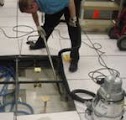When data center construction is complete, data center operations & maintenance begins. These services may include comprehensive operational management and regular scheduled maintenance for all facility supporting infrastructure and assets, or just preventive maintenance for specific assets in the data center. The aim is to provide continuous operations for network services, so it is imperative that your data center support infrastructure be kept in top shape.
Top 10 Ways to Keep Your Data Center Support Infrastructure Up and Running
- Read Your Equipment Manuals Become familiar with your equipment. Equipment manuals outline recommended maintenance and timelines. The documentation will provide details on how to operate under: normal, maintenance, and emergency operating conditions. Human interaction is the #1 cause of unplanned downtime.
- Purchase and Maintain Warranties Purchasing parts on an individual basis is expensive. An active warranty will ensure that whatever breaks will not only be covered, but will save money in the long run.
- Purchase and Maintain On-Site Service Agreements Most of the time, just receiving the replacement part is not enough – now you need someone to install it and make sure it works. In the event of failure, it is best to always have a service contract in place to ensure repair. These agreements usually include preventive maintenance as well.
- Schedule and Perform Regular Preventive Maintenance Visits Regularly scheduled maintenance helps to circumvent downtime by addressing issues early. It greatly reduces the chance of failure. Regular maintenance will also extend the effective service life of your infrastructure.
- Infrared Scanning Over time, heat can build up around sensitive data center equipment, and can ultimately cause failures. Data center hot spots are invisible to the naked eye, and often cannot be detected via touch. Infrared scanning thermographic equipment guarantees you can quickly identify the “hot spot” that may be the source of an eventual failure.
- Keep Detailed Up-to-Date Event and Maintenance Records Consistently documenting the, “who, what, when, where, why, and how” of everything that happens in your data center eliminates questions down the road. Historical work order information can be used to identify chronic equipment problems and/or patterns.
 Monitor Levels and Performance
Regular or real-time monitoring your equipment’s operation ensures you have an understanding of the current operating load versus its capacity and/or redundant capacity limitations. In addition, if you keep a running log, you will have a better understanding of how the load is growing or decreasing, perhaps defining a trend.
Monitor Levels and Performance
Regular or real-time monitoring your equipment’s operation ensures you have an understanding of the current operating load versus its capacity and/or redundant capacity limitations. In addition, if you keep a running log, you will have a better understanding of how the load is growing or decreasing, perhaps defining a trend. Re-Test Under Load
Unfortunately, an unplanned failure is inevitable. When repairs are made, re-testing the equipment with a “dummy” load in a controlled environment will ensure proper operation when the equipment is put back in service.
Re-Test Under Load
Unfortunately, an unplanned failure is inevitable. When repairs are made, re-testing the equipment with a “dummy” load in a controlled environment will ensure proper operation when the equipment is put back in service. Keep it Clean
Don’t forget basic housekeeping. Dust can block airflow and create issues with equipment overheating. Data Center Site Cleaning should be part of your regular maintenance.
Keep it Clean
Don’t forget basic housekeeping. Dust can block airflow and create issues with equipment overheating. Data Center Site Cleaning should be part of your regular maintenance.- Plan for Retirement Nothing lasts forever. Be aware of the expected usable lifespan of your equipment, document it, then plan and budget for its routine maintenance and eventual replacement.














